Chinese Name: 国家大剧院 Pronunciation: Guójiā Dàjùyuàn
Building Time: 2007
Recommended Time for Visit: 1-2 Hours
Occupied Area: 118,900 square meters
Address: No.2 Xichang’an Street, Xicheng District, Beijing, China
Building Function: The center was built to popularize art knowledge and enhance people’s ability of cultural appreciation through various performances and exhibitions.
| Tickets | Periods | |
| May 1st to August 31st | September 1st to April 30th | |
| Adult Ticket | 40 yuan | 30 yuan |
| Discount Ticket (only for seniors aged 60 years old or over with ID cards; women on Women’s Day; one family member who takes children aged 14 years old or under on Children’s Day) |
20 yuan | 15 yuan |
1. Children under 6 years old or under 1.2 meters in height accompanied by an adult are free of charge;
2. Senior citizens over 65 years old (including 65) are free of charge with ID card;
3. The above policy is only applicable to the admission fee.
| Attraction | Period |
| Tuesday to Sunday | |
| National Centre for the Performing Arts | 09:00-17:00 |
1. The center is closed on Monday;
2. No admission is allowed after 16:30.
http://www.chncpa.org/cgyl_278/cggp/?tag=3
https://you.ctrip.com/sight/beijing1/4679013.html
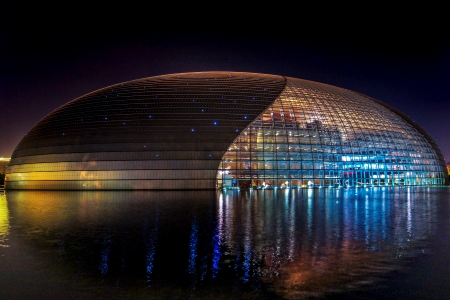
The National Centre for the Performing Arts of China (NCPA), one of the “New 16 Scenic Spots” in Beijing, was built in 2007 and designed by French architect Paul Andreu. The NCPA, the largest theater complex in Asia, is located to the west of Tian’anmen Square. It is even more popular with the name of “Giant Egg”, for its unique egg-like architectural image.
The NCPA consists of a semi-ellipsoidal steel-structured dome, an artificial lake with a total area of 35,500 square meters, and a green belt with a total area of 39,000 square meters. There are four venues in the center: the Opera House, the Concert Hall, the Theater, and the Multi-functional Theater. The four venues are separated but connected by corridors. There are corridors under the water, through which you can get inside the NCPA where you can enjoy different shows, dramas, operas, and the like.
In 1958, the construction plan of the NCPA was designated as one of the top ten buildings for the 10th anniversary of the founding of the People’s Republic of China and won the Luban Prize on December 19, 2008. The NCPA is not only an important cultural facility but also a unique scenic spot. Its unique main structure, the clear lake, and green belt of trees greatly improve the ecological environment of the surrounding areas and show the harmonious and complimentary relationships between people and art, and between human and nature.
In 1958, a number of large-scale public buildings including the NCPA were decided to be built in Beijing to commemorate the 10th anniversary of the founding of the People’s Republic of China.
In October 1997, preparations were started for the construction of the NCPA.
In April 1998, the International Competition of Architectural Design of the NCPA kicked off.
On July 22, 1999, Paul Andreu’s architectural design of the NCPA was adopted.
On December 13, 2001, the construction project of the NCPA was launched.
In September 2007, the construction of the NCPA was basically completed. In December of the same year, the NCPA was officially put into use.
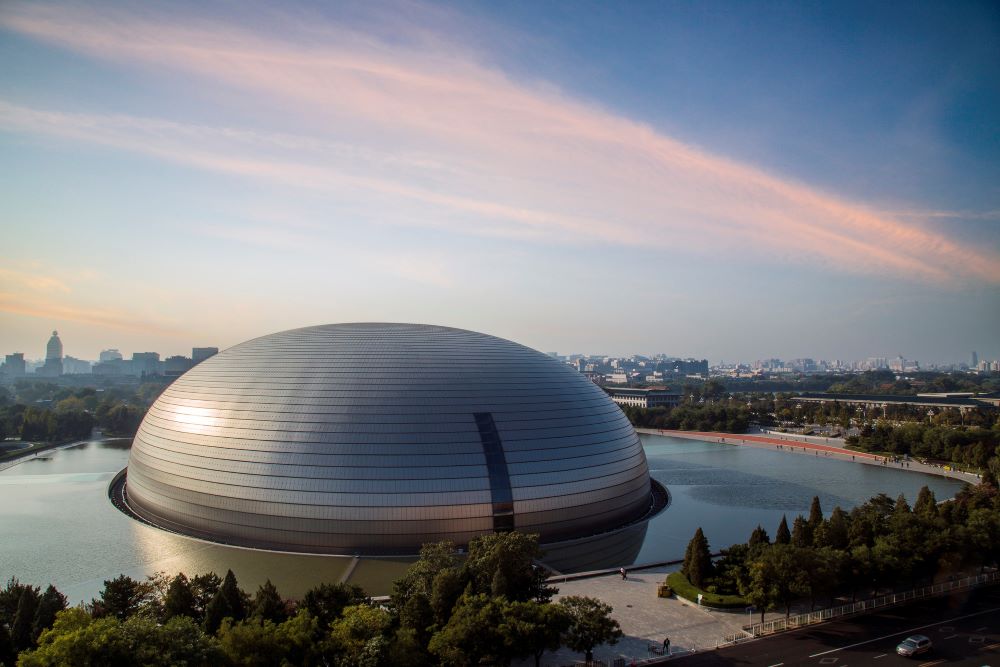
The central structure of the NCPA is an ellipsoid dome covered by steel and glass with a parameter of more than 600 meters. The dome looks immaculate and magnificent, with its surface covered by 18,398 titanium plates and 1,226 pieces of ultra-transparent glass which are skillfully spliced to present aesthetic curves on the dome.
The building is 46.68 meters in height and 32.50 meters in depth. The egg-shaped shell appears to float in a man-made lake which covers an area of 35,500 square meters and is full of gleaming water. With the high-tech water circulation system, the lake water will not freeze in winter and the algae will not grow in it in summer either. The lake is surrounded by a green belt of trees with a total area of 39,000 square meters, which blocks the hustle and bustle noise from the traffic, making the NCPA a spacious place for relaxation and leisure in the heart of the city.
The Opera House
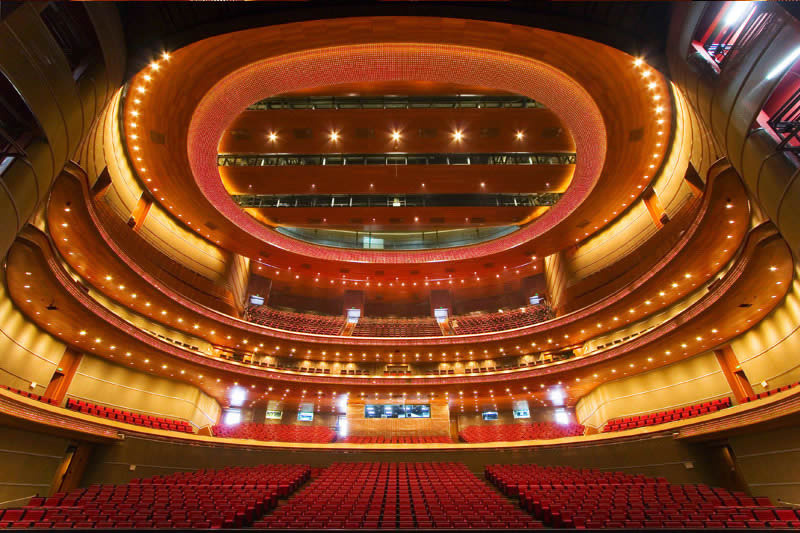
The Opera House is the grandest venue in the NCPA, with golden color as its main tone, making it brilliant and splendid. The house mainly stages dance dramas, operas, ballets, and large-scale artistic performances. There are stalls and three higher levels of balconies in the auditorium, which can seat 2,081 audiences.
The Opera House is equipped with a modern stage that can be moved up, down, backward, forward, or even rotated, a ballet stage that can slant, and a rising orchestra pit that can hold a 90-musician orchestra. These advanced mechanisms and equipment provide artists with enormous possibilities for creative performance.
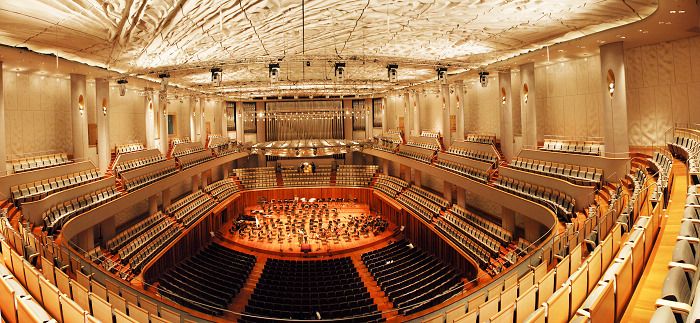
The overall style of the Concert Hall is fresh and elegant. It is suitable for staging large-scale symphonies and national music and holding various concerts and other forms of music performances. The stage is surrounded by 1,859 seats in the stalls and two levels of balconies.
The walls and ceiling of the hall are specially designed, which can diffuse and reflect the sound evenly to every corner of the hall to achieve the best reverberation effect. The Concert Hall houses China’s biggest pipe organ which is a unique treasure. All the interior structures and decorations are so designed as to realize the best acoustic effect, thus achieving a perfect integration of architectural beauty and up-to-date acoustic technology.
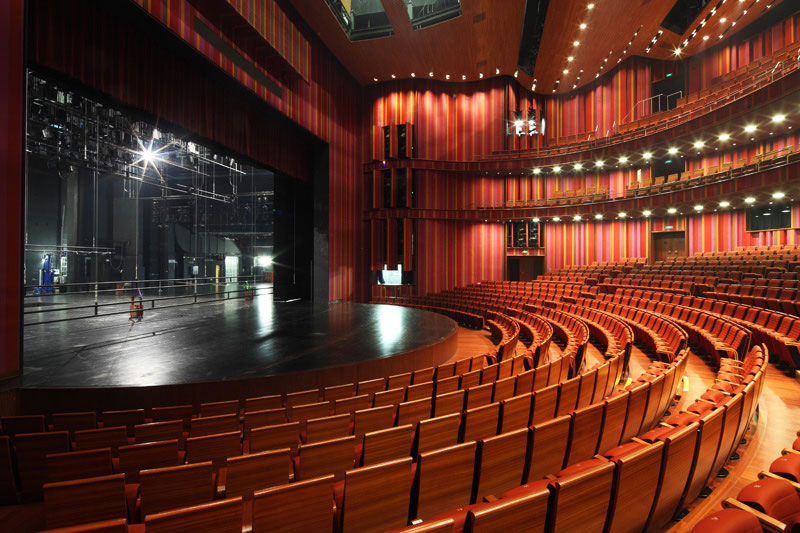
The Theatre is a venue with the most distinctive Chinese style, characterized by its Chinese-Red color tone, mainly used for the performances including drama, opera, and local opera. The surrounding walls were decorated with silk, making them more elegant. In the audience area, there are 957 seats located in the stalls and three levels of balconies.
The stage is equipped with high-tech, theatrical stage and audio-visual equipment, which enables actors to transform creative thought into performing reality. Besides, the walls of the Theatre are subtly designed as well in order to make the sounds more beautiful. Its unique protruding apron stage is most appropriate for Chinese traditional theatrical performance.
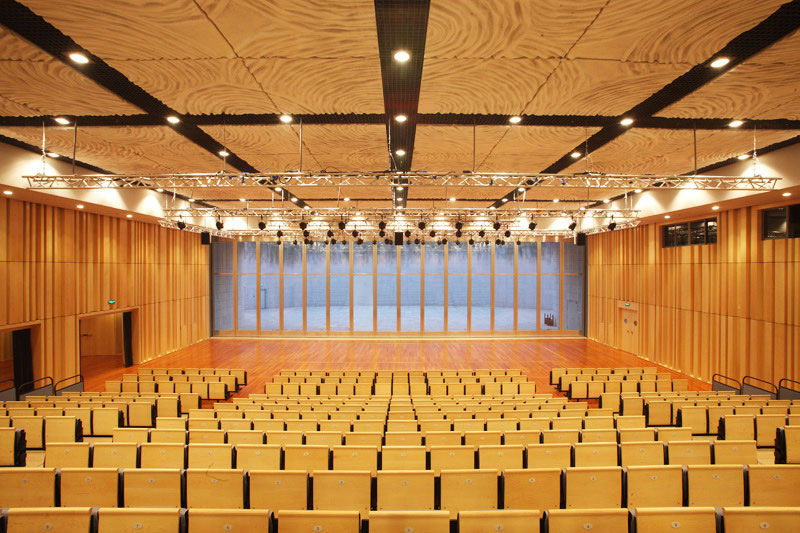
The Multi-functional Theatre is the most diversified venue to host different types of performances. The style inside is tranquil and elegant. Its style suits chamber music, instrumental solo and vocal solo, drama, and modern dance. There are 19 rows and 469 seats (including movable seats) in the auditorium.
The Multi-functional Theatre was completed in September 2009, officially opened to the public in October 2009. Its completion not only further extends the functional capability of the NCPA but also enriches the performing function of the existing small theatres in Beijing.
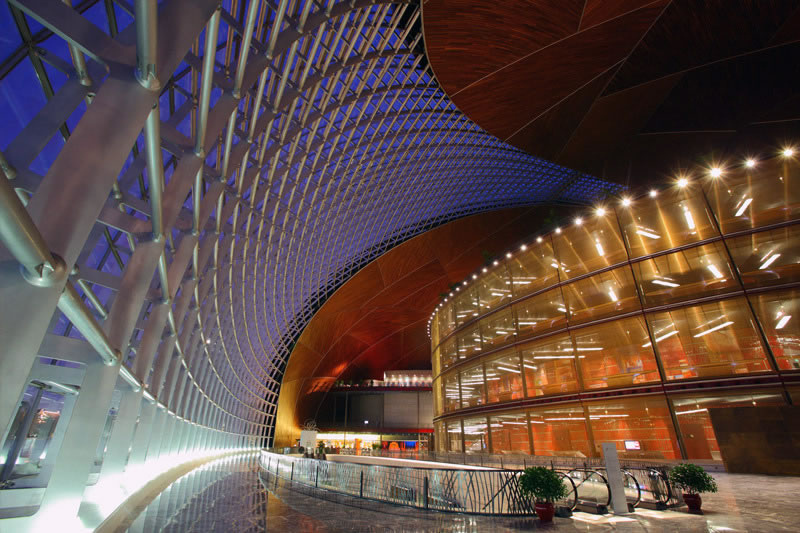
Apart from the three big professional theatres and the small theatre, there is a spacious area of public spaces inside the giant NCPA building, where visitors can appreciate the splendor and vigor of the NCPA which is exquisitely and uniquely designed architecture with enriched artistic displays. What’s more, visitors can also visit art exhibitions in various themes, and enjoy all kinds of art performances. The Fifth Space creates the possibility of personally experiencing the glamorous power of arts to its audience.
Take bus 52, and get off at Shibei Hutong Station.
Take bus 1, 5, 52, Tourism 1, or Tourism 2 and get off at Tian’anmen Xi Station.
Take Subway Line 1, get off at Tian’anmen Xi Station and exit C.
Take Subway Line 2, get off at Hepingmen Station and exit B1.
Chinese: 请带我去国家大剧院。English: Please take me to the National Centre for the Performing Arts.
If you go to the National Centre for the Performing Arts from the center of Beijing (Grand Hyatt Beijing), it takes about 15 minutes (about 20 yuan).
If you go to the National Centre for the Performing Arts from Beijing Capital International Airport, it takes about 70 minutes (about 95 yuan).
If you go to the National Centre for the Performing Arts from Beijing Daxing International Airport, it takes about 75 minutes (about 170 yuan).
If you go to the National Centre for the Performing Arts from Beijing West Train Station, it takes about 20 minutes (about 30 yuan).
